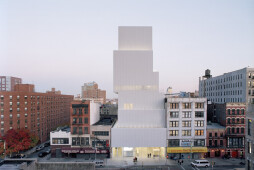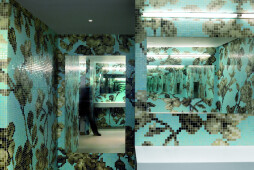In December 2007, the New Museum opened on the Bowery with a building designed by acclaimed architects Sejima + Nishizawa/SANAA. SANAA conceived of the Museum as a sculptural stack of rectilinear boxes shifted off-axis around a central steel core. This innovative approach produced a variety of open, fluid, and light-filled spaces, each with a different character. At the heart of the New Museum’s seven-story building are three floors of column-free galleries. Each is distinguished by a different ceiling height and unique location of skylights created by the setbacks where the stories shift. The ground floor of the new facility, the Marcia Tucker Hall, includes a glass-walled gallery, a café, and the renowned New Museum Store. The New Museum also has a 182-seat theater for performances and events, a fifth-floor Education Center, and a top-floor Sky Room for public and private events. The use of industrial materials is in keeping with the commercial character of the Bowery, and SANAA has used them in a way that is at once beautiful and rough, gritty and elegant. There is a deliberate openness to the building, with its glass storefront, and a desire for structural transparency making the building’s materials visible, from the steel to the ductwork to the freight coming in and out of the loading bay. The exterior is clad in a seamless, anodized aluminum mesh, which emphasizes the volumes of the boxes while dressing the whole building in a delicate, softly shimmering skin. The structure appears as a monolithic form, but also a mutable and dynamic one which is animated by the changing light of the day—a perfect metaphor for the ever-changing nature of contemporary art.
The New Museum is the only museum with the mission to promote new art and new ideas, and the only museum in New York City devoted exclusively to international contemporary art. Founded in 1977, the New Museum was conceived as a center for exhibitions, information, and documentation about living artists whose work did not yet have wide public exposure or critical acceptance. It has a unique history of being founded by a curator— Marcia Tucker—who had neither personal resources nor a collection, just abundant resourcefulness and a
passion for living culture. At its inception, the Museum lay somewhere between a grassroots alternative space and a major museum devoted to proven historical values. The deliberate paradox was embodied in the name “New Museum” and in Tucker’s daring vision and combative idea to present new art in a critical and scholarly context.
The New Museum has evolved over the past three decades, from its humble beginnings in a one-room office on Hudson Street in 1977, to a gallery space in the New School later that year, to its expansion and relocation to SoHo in 1983, to the inauguration of its first freestanding, dedicated building in 2007. Our culture has also evolved during this time and contemporary art is more widely embraced today. The New Museum has an important and influential legacy and mission to keep breaking new ground. A site of ongoing experimentation and questioning of what art and institutions can be in the twenty-first century, the New Museum continues to look to the future through programming that is open, fearless, and alive.
























































